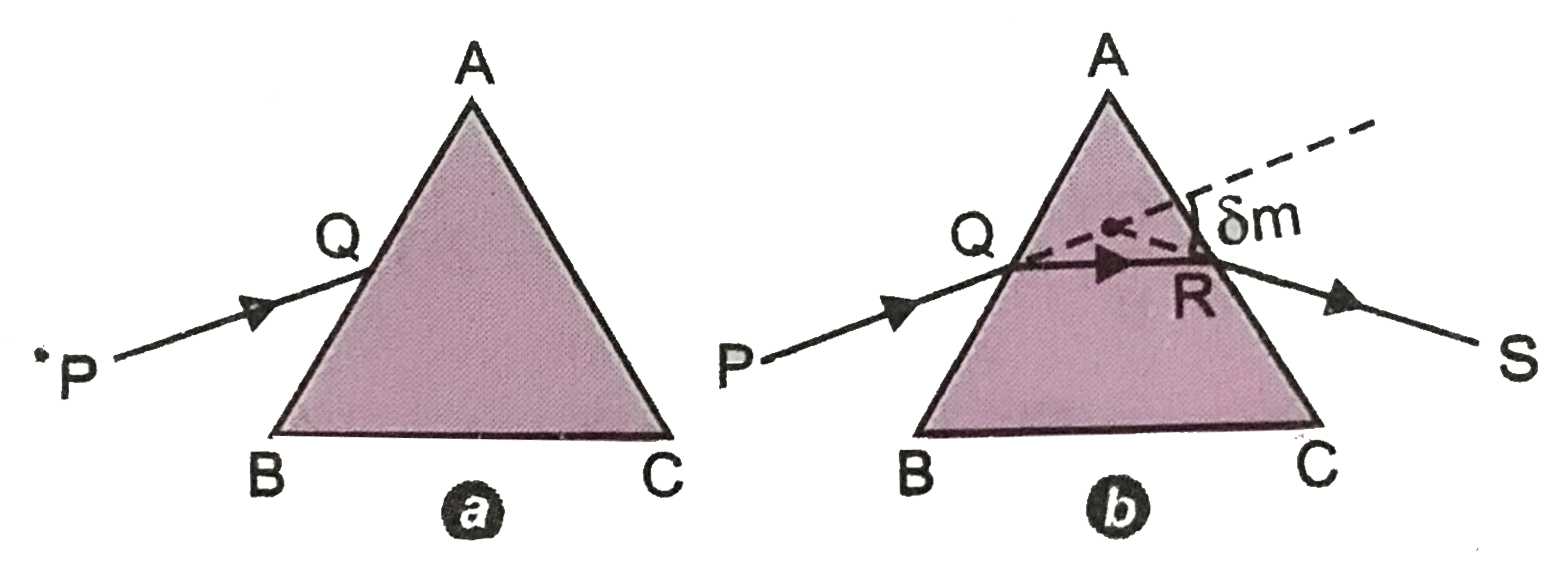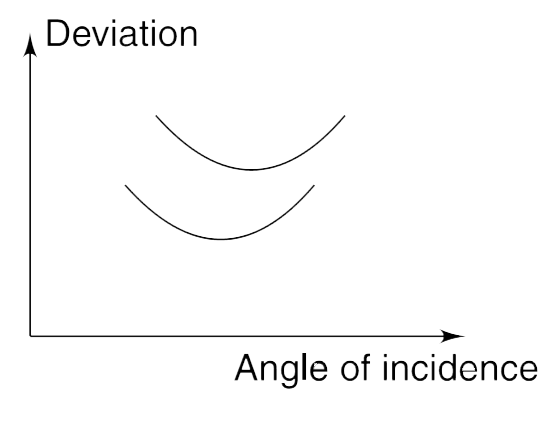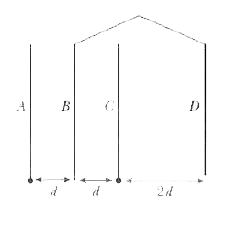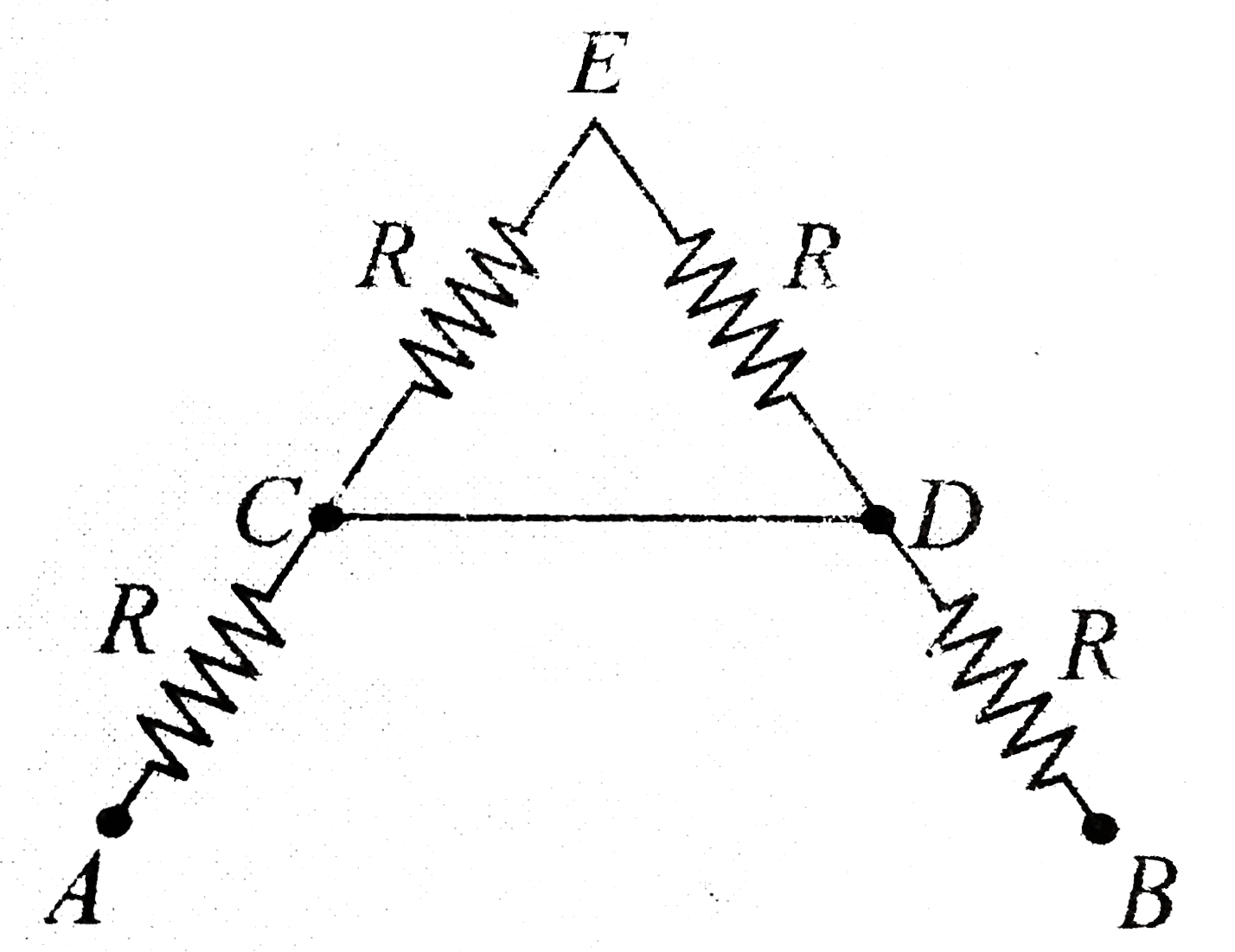Four similar prisms of same material having same angle of prism are arranged. Which among the four of the arrangements shown in the following figures gives no not angular deviation ?




The correct Answer is:B
To solve the question regarding the arrangement of four similar prisms of the same material and the same angle of prism, we will analyze each arrangement to determine which one results in no angular deviation of the light ray passing through them.
1. Understanding the Concept of Angular Deviation:
- When light passes through a prism, it bends towards the base of the prism. The amount of bending is quantified as angular deviation. If multiple prisms are arranged in such a way that their effects on the light ray cancel each other out, then the net angular deviation can be zero.
2. Analyzing Arrangement A:
- In the first arrangement, a light ray enters the first prism, bends towards the base, exits, and then enters the second prism. Each prism causes a deviation in the light ray. As the light continues through the prisms, it will have a net angular deviation.
- Conclusion: Arrangement A has a net angular deviation.
3. Analyzing Arrangement B:
- In the second arrangement, the prisms are arranged in such a way that the light ray enters the first prism, bends towards the base, and then enters the second prism. The second prism will counteract the deviation caused by the first prism, and this pattern continues with the subsequent prisms.
- Since each prism's deviation is countered by the next, the light ray will exit parallel to its original path, resulting in no net angular deviation.
- Conclusion: Arrangement B has no angular deviation.
4. Analyzing Arrangement C:
- In this arrangement, all prisms are stacked together. The light ray will pass through all prisms as if it were passing through a single prism. Since a single prism always causes some angular deviation, this arrangement will also have a net angular deviation.
- Conclusion: Arrangement C has a net angular deviation.
5. Analyzing Arrangement D:
- In the fourth arrangement, the prisms are arranged in a way that resembles a single prism with a 90-degree angle. The light ray will bend towards the base and then exit, resulting in a net angular deviation.
- Conclusion: Arrangement D has a net angular deviation.
Final Answer:
The arrangement that gives no angular deviation is Arrangement B.
- When light passes through a prism, it bends towards the base of the prism. The amount of bending is quantified as angular deviation. If multiple prisms are arranged in such a way that their effects on the light ray cancel each other out, then the net angular deviation can be zero.
- In the first arrangement, a light ray enters the first prism, bends towards the base, exits, and then enters the second prism. Each prism causes a deviation in the light ray. As the light continues through the prisms, it will have a net angular deviation.
- Conclusion: Arrangement A has a net angular deviation.
- In the second arrangement, the prisms are arranged in such a way that the light ray enters the first prism, bends towards the base, and then enters the second prism. The second prism will counteract the deviation caused by the first prism, and this pattern continues with the subsequent prisms.
- Since each prism's deviation is countered by the next, the light ray will exit parallel to its original path, resulting in no net angular deviation.
- Conclusion: Arrangement B has no angular deviation.
- In this arrangement, all prisms are stacked together. The light ray will pass through all prisms as if it were passing through a single prism. Since a single prism always causes some angular deviation, this arrangement will also have a net angular deviation.
- Conclusion: Arrangement C has a net angular deviation.
- In the fourth arrangement, the prisms are arranged in a way that resembles a single prism with a 90-degree angle. The light ray will bend towards the base and then exit, resulting in a net angular deviation.
- Conclusion: Arrangement D has a net angular deviation.
The arrangement that gives no angular deviation is Arrangement B.
Topper's Solved these Questions
- BOOK - RESNICK AND HALLIDAYCHAPTER - GEOMETRICAL OPTICS : REFRACTIONEXERCISE - Practice questions(More than one correct choice type)14videos
GEOMETRICAL OPTICS : REFRACTION
- BOOK - RESNICK AND HALLIDAYCHAPTER - GEOMETRICAL OPTICS : REFRACTIONEXERCISE - Practice questions(Linked Comprehension)2videos
GEOMETRICAL OPTICS : REFRACTION
- BOOK - RESNICK AND HALLIDAYCHAPTER - GEOMETRICAL OPTICS : REFRACTIONEXERCISE - Problems44videos
GEOMETRICAL OPTICS : REFRACTION
- BOOK - RESNICK AND HALLIDAYCHAPTER - GEOMETRICAL OPTICS : REFLECTION EXERCISE - PRACTICE QUESTIONS (Integer Type)3videos
GEOMETRICAL OPTICS : REFLECTION
- BOOK - RESNICK AND HALLIDAYCHAPTER - GRAVITATIONEXERCISE - PRACTICE QUESTIONS (INTEGER TYPE)4videos
GRAVITATION
Similar Questions
A ray PQ incident on face AB of a prism ABC, as shown in Fig., emerges from the face AC such that AQ=AR. Draw the ray diagram showing the pasage of the ray through the prism. If the angle of prism is 60∘ and refractive index of the material of the prism is √3, determine the values of angle of incidence and angle of deviation.
 .View Solution
.View SolutionThe plot of deviation versus angle of incidence for two prisms made of same material has been shown in the Figure. Which of the two graph corresponds to the prism of higher refracting angle (A)?
 View Solution
View Solution
Knowledge Check
- Question 1 - Select One
Four square plates, each with edge length a, are arranged as shown in the following figure. The equivalent capacitance between A and C is
 A3ε0a25dB3ε0a22dC2ε0a23dD5ε0a23d
A3ε0a25dB3ε0a22dC2ε0a23dD5ε0a23d - Question 2 - Select One
Four wires of the same material are stretched by the same load. Which one of them will elongate most if their dimensions are as follows
AL = 100 cm , r = 1mmBL = 200 cm , r = 3 mmCL = 300 , r = 3 mmDL = 400, r = 4mm - Question 3 - Select One
Four wires made of same material have different lengths and radii, the wire having more resistance in the following case is
Al=100cm,r=1mmBl=50cm,r=2mmCl=100cm,r=12mmDl=50cm,r=12mm
Four wires made of same material have different lengths and radii, the wire having more resistance in the following case is
View SolutionWhich of the following arrangements of four bar magnets is not possible?
View SolutionFour identical resistances each having value R are arranged as shown in Figure. Find the equivalent resistance between A and B.
 View Solution
View SolutionThe following four wires are made of same material. Which of these will have the largest extension when the same tension is applied?
View SolutionThere is a thin prism of angle 5∘ made of material having refractive index 1.6. There is another thin prism made of material of refractive index 1.8. These two prisms are combined in such a manner that they may produce dispersion without mean deviation. What should be the angle of second prism ?
View Solution

